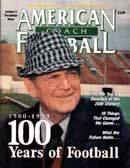AMERICAN FOOTBALL MONTHLY THE #1 RESOURCE FOR FOOTBALL COACHES
Article CategoriesAFM Magazine
|
3-Step Passing GameAssistant Coach, Troy State© More from this issue A three-step passing game has become a vital part of most offenses. At Troy State, we utilize quick passes to enhance our running attack. Our players refer to the three-step game as "long handoffs." The reason we believe the quick passing game is such an important aspect to the running game is the advent of eight- and nine-man fronts being employed by defenses. These fronts have made running the football a huge challenge. By including the three-step passing game with our running game, we are trying to put the pressure back on the defense. These quick throws can take advantage of any mistake made by the secondary with a lot of open field to work with. It also has enabled us to still control the ball and the clock when the running game isn't working well. We teach the three-step passing game as a mirror image of our runnin....The full article can only be seen by subscribers.
|
|
|||||||
| HOME |
MAGAZINE |
SUBSCRIBE | ONLINE COLUMNISTS | COACHING VIDEOS |
Copyright 2025, AmericanFootballMonthly.com
All Rights Reserved





